MBA402 - Governance, Ethics, and Sustainability: Timberwell Report
VerifiedAdded on 2023/01/19
|12
|2646
|20
Report
AI Summary
This report provides a comprehensive sustainability assessment of Timberwell Construction Company, examining its economic, environmental, and social performance. The assessment covers key areas such as climate change, corruption, anti-competitive behavior, energy consumption, environmental impact on biodiversity, and compliance with environmental laws, all in accordance with GRI reporting standards. The report details the company's responses to challenges, including changes in building guidelines due to climate change, incidents of corruption, and anti-competitive market practices. It also explores the company's energy consumption, its impact on the environment, and violations of environmental laws. Furthermore, it analyzes the company's social sustainability, focusing on employment practices, discrimination issues, and community engagement initiatives. The conclusion synthesizes the findings, highlighting the company's strengths and weaknesses in each sustainability area and offering insights into its overall sustainability profile. The report provides a detailed overview of the company's performance and offers key recommendations for improvement in various areas.
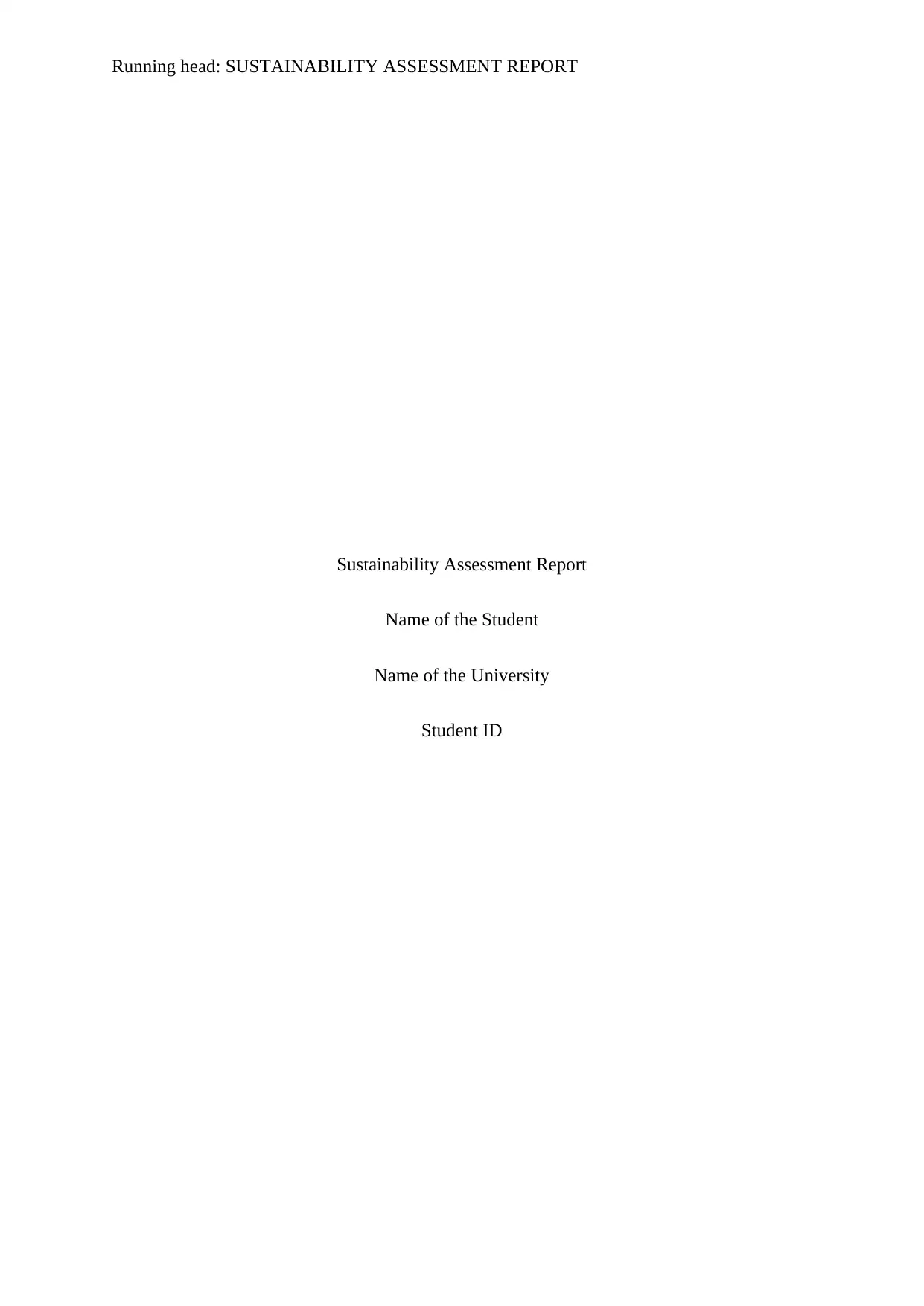
Running head: SUSTAINABILITY ASSESSMENT REPORT
Sustainability Assessment Report
Name of the Student
Name of the University
Student ID
Sustainability Assessment Report
Name of the Student
Name of the University
Student ID
Paraphrase This Document
Need a fresh take? Get an instant paraphrase of this document with our AI Paraphraser
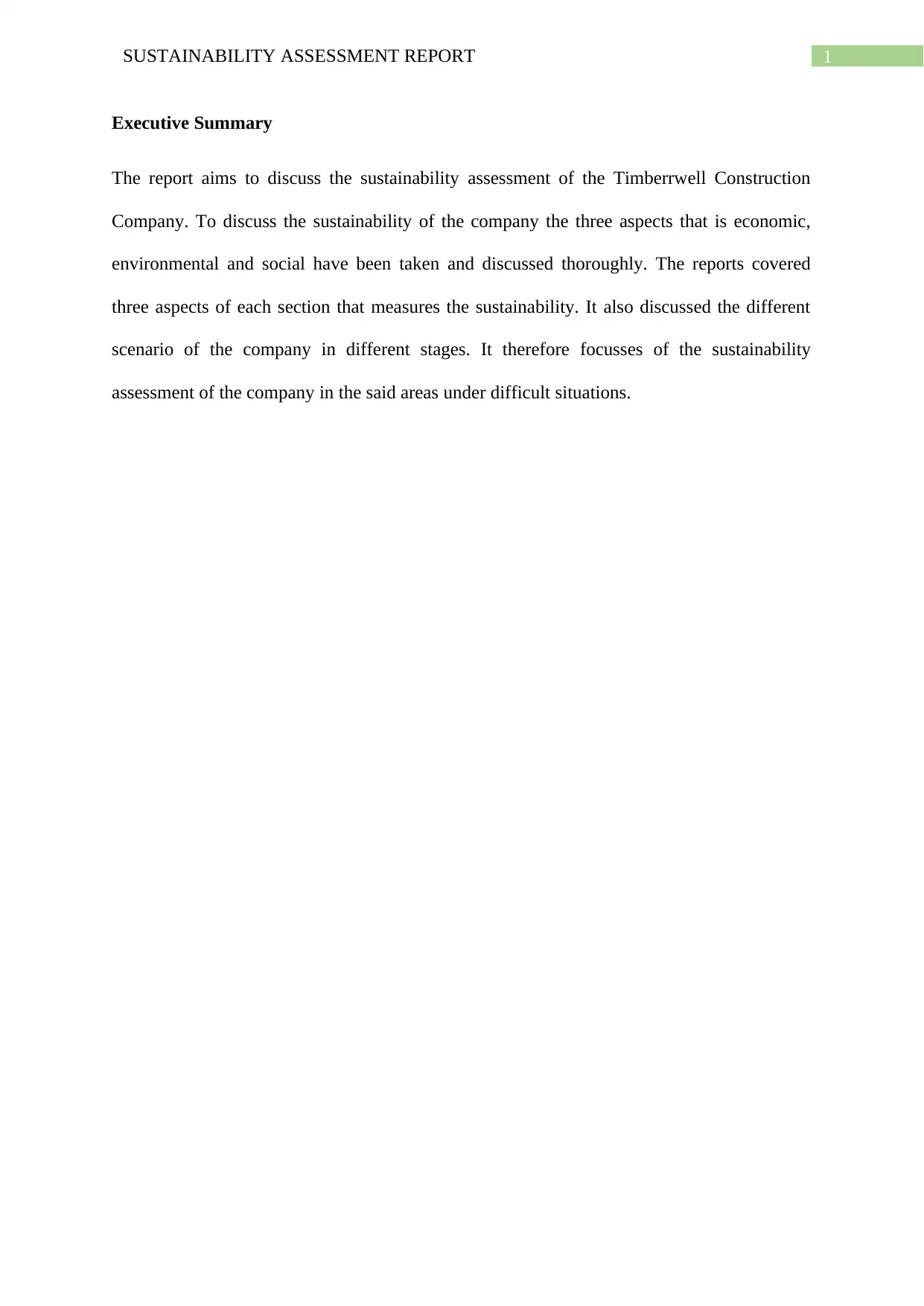
1SUSTAINABILITY ASSESSMENT REPORT
Executive Summary
The report aims to discuss the sustainability assessment of the Timberrwell Construction
Company. To discuss the sustainability of the company the three aspects that is economic,
environmental and social have been taken and discussed thoroughly. The reports covered
three aspects of each section that measures the sustainability. It also discussed the different
scenario of the company in different stages. It therefore focusses of the sustainability
assessment of the company in the said areas under difficult situations.
Executive Summary
The report aims to discuss the sustainability assessment of the Timberrwell Construction
Company. To discuss the sustainability of the company the three aspects that is economic,
environmental and social have been taken and discussed thoroughly. The reports covered
three aspects of each section that measures the sustainability. It also discussed the different
scenario of the company in different stages. It therefore focusses of the sustainability
assessment of the company in the said areas under difficult situations.
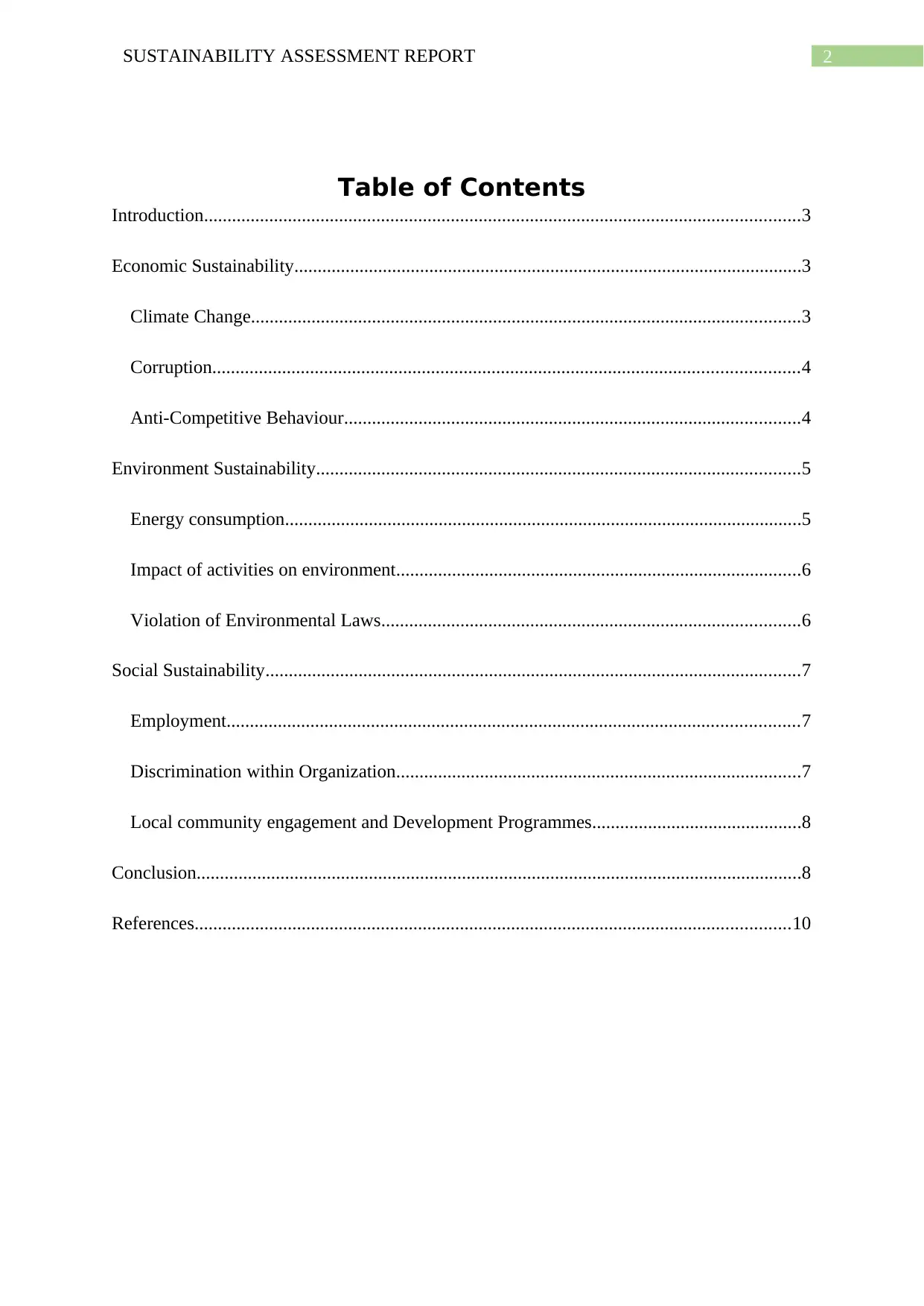
2SUSTAINABILITY ASSESSMENT REPORT
Table of Contents
Introduction................................................................................................................................3
Economic Sustainability.............................................................................................................3
Climate Change......................................................................................................................3
Corruption..............................................................................................................................4
Anti-Competitive Behaviour..................................................................................................4
Environment Sustainability........................................................................................................5
Energy consumption...............................................................................................................5
Impact of activities on environment.......................................................................................6
Violation of Environmental Laws..........................................................................................6
Social Sustainability...................................................................................................................7
Employment...........................................................................................................................7
Discrimination within Organization.......................................................................................7
Local community engagement and Development Programmes.............................................8
Conclusion..................................................................................................................................8
References................................................................................................................................10
Table of Contents
Introduction................................................................................................................................3
Economic Sustainability.............................................................................................................3
Climate Change......................................................................................................................3
Corruption..............................................................................................................................4
Anti-Competitive Behaviour..................................................................................................4
Environment Sustainability........................................................................................................5
Energy consumption...............................................................................................................5
Impact of activities on environment.......................................................................................6
Violation of Environmental Laws..........................................................................................6
Social Sustainability...................................................................................................................7
Employment...........................................................................................................................7
Discrimination within Organization.......................................................................................7
Local community engagement and Development Programmes.............................................8
Conclusion..................................................................................................................................8
References................................................................................................................................10
⊘ This is a preview!⊘
Do you want full access?
Subscribe today to unlock all pages.

Trusted by 1+ million students worldwide
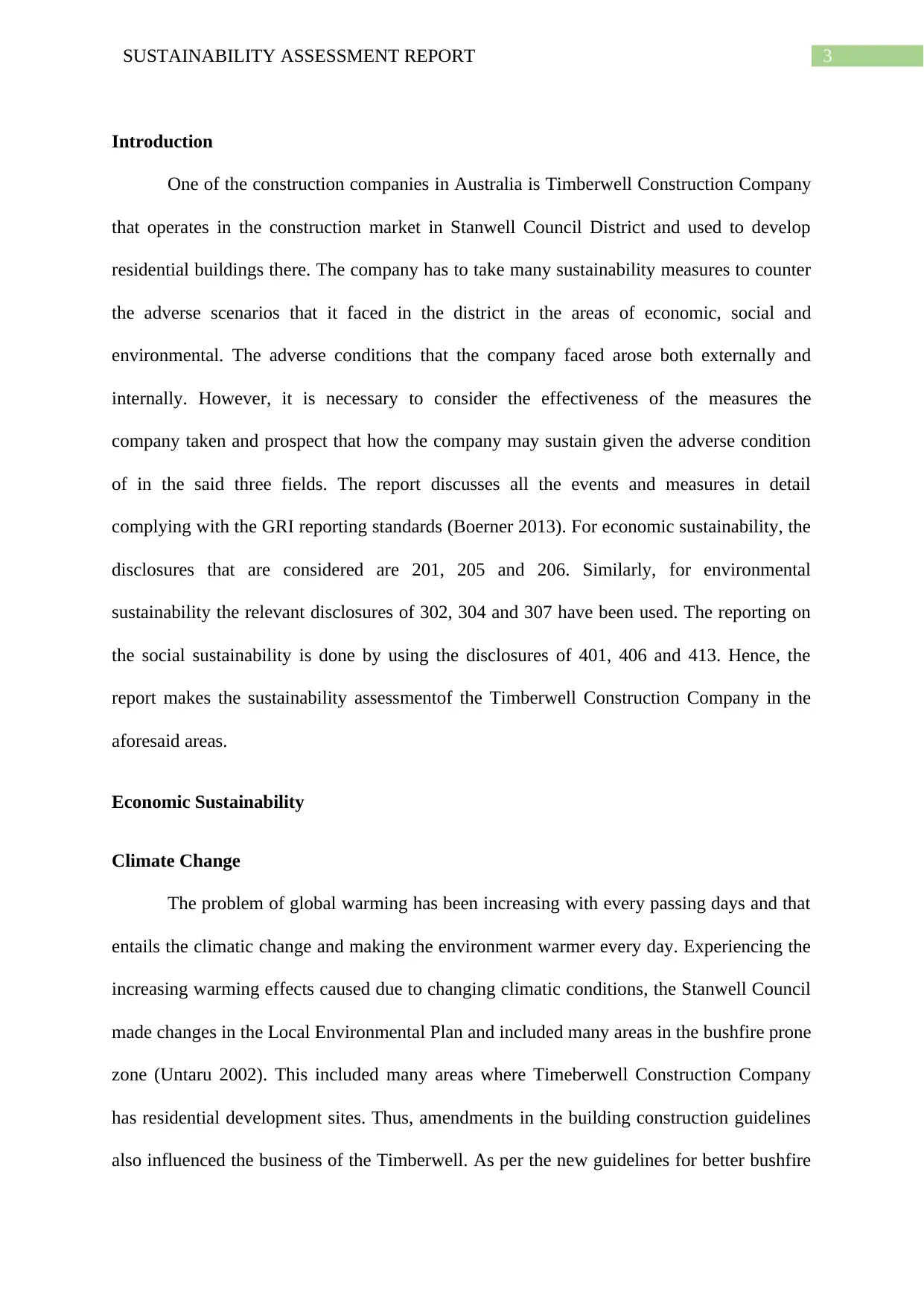
3SUSTAINABILITY ASSESSMENT REPORT
Introduction
One of the construction companies in Australia is Timberwell Construction Company
that operates in the construction market in Stanwell Council District and used to develop
residential buildings there. The company has to take many sustainability measures to counter
the adverse scenarios that it faced in the district in the areas of economic, social and
environmental. The adverse conditions that the company faced arose both externally and
internally. However, it is necessary to consider the effectiveness of the measures the
company taken and prospect that how the company may sustain given the adverse condition
of in the said three fields. The report discusses all the events and measures in detail
complying with the GRI reporting standards (Boerner 2013). For economic sustainability, the
disclosures that are considered are 201, 205 and 206. Similarly, for environmental
sustainability the relevant disclosures of 302, 304 and 307 have been used. The reporting on
the social sustainability is done by using the disclosures of 401, 406 and 413. Hence, the
report makes the sustainability assessmentof the Timberwell Construction Company in the
aforesaid areas.
Economic Sustainability
Climate Change
The problem of global warming has been increasing with every passing days and that
entails the climatic change and making the environment warmer every day. Experiencing the
increasing warming effects caused due to changing climatic conditions, the Stanwell Council
made changes in the Local Environmental Plan and included many areas in the bushfire prone
zone (Untaru 2002). This included many areas where Timeberwell Construction Company
has residential development sites. Thus, amendments in the building construction guidelines
also influenced the business of the Timberwell. As per the new guidelines for better bushfire
Introduction
One of the construction companies in Australia is Timberwell Construction Company
that operates in the construction market in Stanwell Council District and used to develop
residential buildings there. The company has to take many sustainability measures to counter
the adverse scenarios that it faced in the district in the areas of economic, social and
environmental. The adverse conditions that the company faced arose both externally and
internally. However, it is necessary to consider the effectiveness of the measures the
company taken and prospect that how the company may sustain given the adverse condition
of in the said three fields. The report discusses all the events and measures in detail
complying with the GRI reporting standards (Boerner 2013). For economic sustainability, the
disclosures that are considered are 201, 205 and 206. Similarly, for environmental
sustainability the relevant disclosures of 302, 304 and 307 have been used. The reporting on
the social sustainability is done by using the disclosures of 401, 406 and 413. Hence, the
report makes the sustainability assessmentof the Timberwell Construction Company in the
aforesaid areas.
Economic Sustainability
Climate Change
The problem of global warming has been increasing with every passing days and that
entails the climatic change and making the environment warmer every day. Experiencing the
increasing warming effects caused due to changing climatic conditions, the Stanwell Council
made changes in the Local Environmental Plan and included many areas in the bushfire prone
zone (Untaru 2002). This included many areas where Timeberwell Construction Company
has residential development sites. Thus, amendments in the building construction guidelines
also influenced the business of the Timberwell. As per the new guidelines for better bushfire
Paraphrase This Document
Need a fresh take? Get an instant paraphrase of this document with our AI Paraphraser
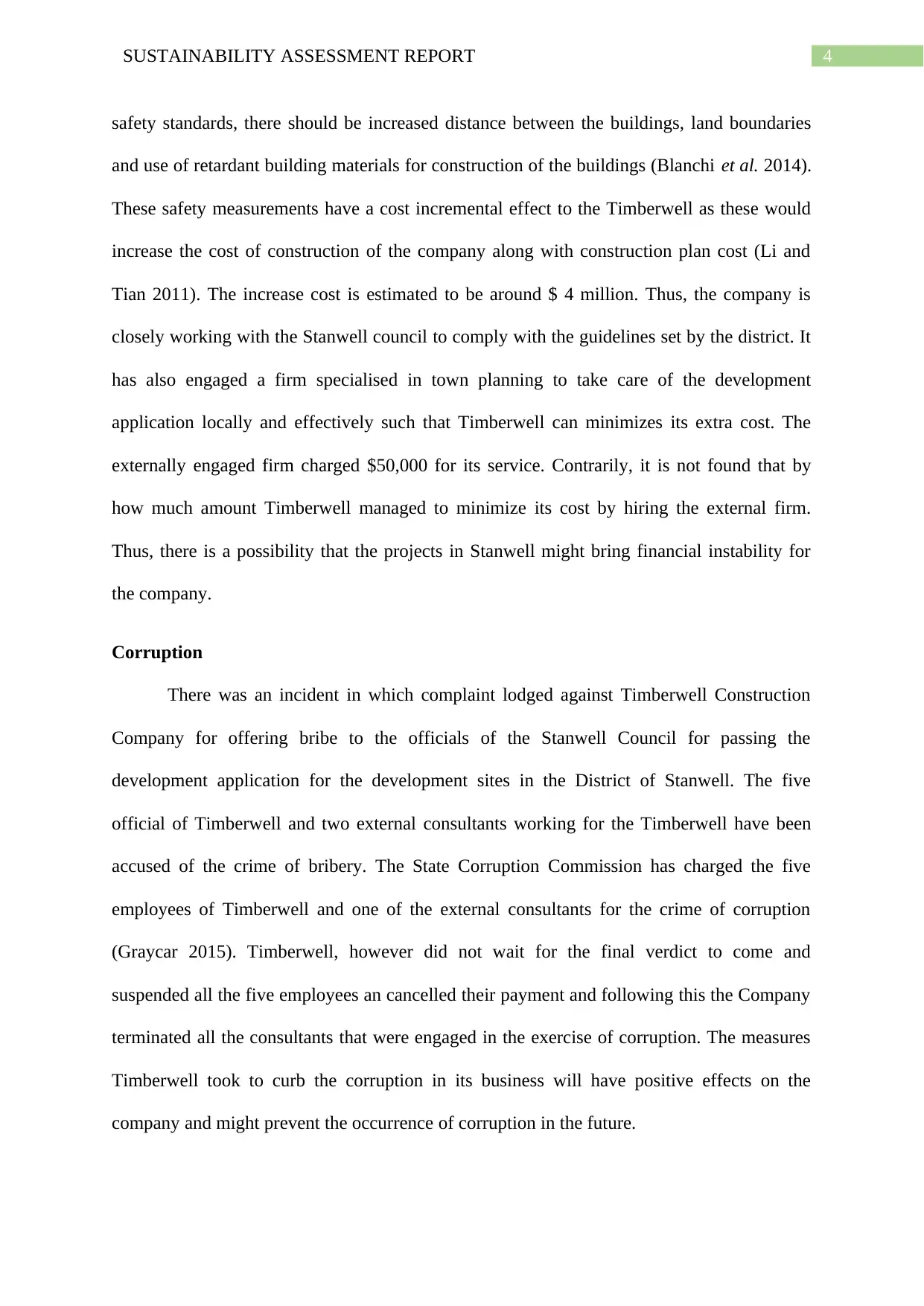
4SUSTAINABILITY ASSESSMENT REPORT
safety standards, there should be increased distance between the buildings, land boundaries
and use of retardant building materials for construction of the buildings (Blanchi et al. 2014).
These safety measurements have a cost incremental effect to the Timberwell as these would
increase the cost of construction of the company along with construction plan cost (Li and
Tian 2011). The increase cost is estimated to be around $ 4 million. Thus, the company is
closely working with the Stanwell council to comply with the guidelines set by the district. It
has also engaged a firm specialised in town planning to take care of the development
application locally and effectively such that Timberwell can minimizes its extra cost. The
externally engaged firm charged $50,000 for its service. Contrarily, it is not found that by
how much amount Timberwell managed to minimize its cost by hiring the external firm.
Thus, there is a possibility that the projects in Stanwell might bring financial instability for
the company.
Corruption
There was an incident in which complaint lodged against Timberwell Construction
Company for offering bribe to the officials of the Stanwell Council for passing the
development application for the development sites in the District of Stanwell. The five
official of Timberwell and two external consultants working for the Timberwell have been
accused of the crime of bribery. The State Corruption Commission has charged the five
employees of Timberwell and one of the external consultants for the crime of corruption
(Graycar 2015). Timberwell, however did not wait for the final verdict to come and
suspended all the five employees an cancelled their payment and following this the Company
terminated all the consultants that were engaged in the exercise of corruption. The measures
Timberwell took to curb the corruption in its business will have positive effects on the
company and might prevent the occurrence of corruption in the future.
safety standards, there should be increased distance between the buildings, land boundaries
and use of retardant building materials for construction of the buildings (Blanchi et al. 2014).
These safety measurements have a cost incremental effect to the Timberwell as these would
increase the cost of construction of the company along with construction plan cost (Li and
Tian 2011). The increase cost is estimated to be around $ 4 million. Thus, the company is
closely working with the Stanwell council to comply with the guidelines set by the district. It
has also engaged a firm specialised in town planning to take care of the development
application locally and effectively such that Timberwell can minimizes its extra cost. The
externally engaged firm charged $50,000 for its service. Contrarily, it is not found that by
how much amount Timberwell managed to minimize its cost by hiring the external firm.
Thus, there is a possibility that the projects in Stanwell might bring financial instability for
the company.
Corruption
There was an incident in which complaint lodged against Timberwell Construction
Company for offering bribe to the officials of the Stanwell Council for passing the
development application for the development sites in the District of Stanwell. The five
official of Timberwell and two external consultants working for the Timberwell have been
accused of the crime of bribery. The State Corruption Commission has charged the five
employees of Timberwell and one of the external consultants for the crime of corruption
(Graycar 2015). Timberwell, however did not wait for the final verdict to come and
suspended all the five employees an cancelled their payment and following this the Company
terminated all the consultants that were engaged in the exercise of corruption. The measures
Timberwell took to curb the corruption in its business will have positive effects on the
company and might prevent the occurrence of corruption in the future.
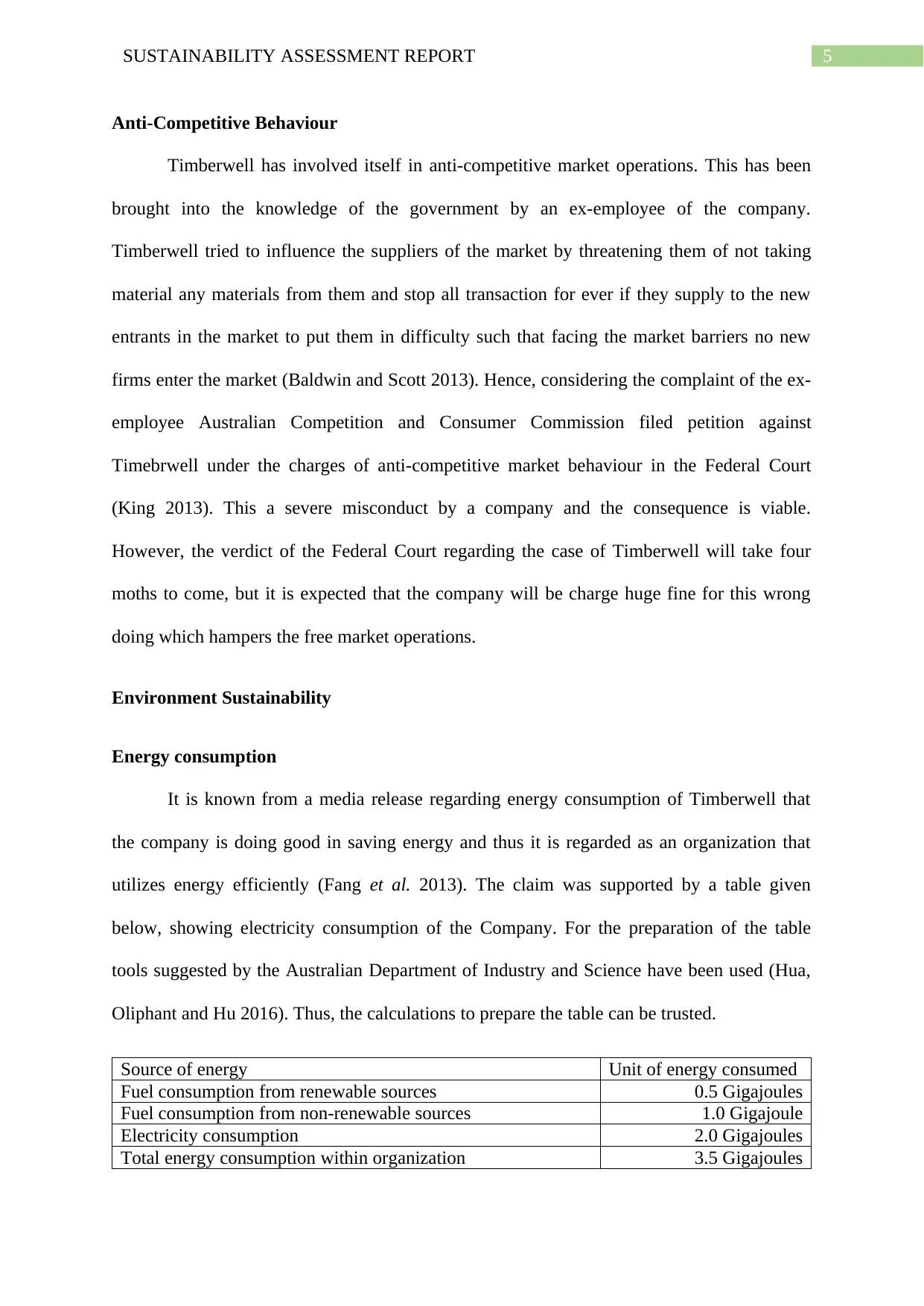
5SUSTAINABILITY ASSESSMENT REPORT
Anti-Competitive Behaviour
Timberwell has involved itself in anti-competitive market operations. This has been
brought into the knowledge of the government by an ex-employee of the company.
Timberwell tried to influence the suppliers of the market by threatening them of not taking
material any materials from them and stop all transaction for ever if they supply to the new
entrants in the market to put them in difficulty such that facing the market barriers no new
firms enter the market (Baldwin and Scott 2013). Hence, considering the complaint of the ex-
employee Australian Competition and Consumer Commission filed petition against
Timebrwell under the charges of anti-competitive market behaviour in the Federal Court
(King 2013). This a severe misconduct by a company and the consequence is viable.
However, the verdict of the Federal Court regarding the case of Timberwell will take four
moths to come, but it is expected that the company will be charge huge fine for this wrong
doing which hampers the free market operations.
Environment Sustainability
Energy consumption
It is known from a media release regarding energy consumption of Timberwell that
the company is doing good in saving energy and thus it is regarded as an organization that
utilizes energy efficiently (Fang et al. 2013). The claim was supported by a table given
below, showing electricity consumption of the Company. For the preparation of the table
tools suggested by the Australian Department of Industry and Science have been used (Hua,
Oliphant and Hu 2016). Thus, the calculations to prepare the table can be trusted.
Source of energy Unit of energy consumed
Fuel consumption from renewable sources 0.5 Gigajoules
Fuel consumption from non-renewable sources 1.0 Gigajoule
Electricity consumption 2.0 Gigajoules
Total energy consumption within organization 3.5 Gigajoules
Anti-Competitive Behaviour
Timberwell has involved itself in anti-competitive market operations. This has been
brought into the knowledge of the government by an ex-employee of the company.
Timberwell tried to influence the suppliers of the market by threatening them of not taking
material any materials from them and stop all transaction for ever if they supply to the new
entrants in the market to put them in difficulty such that facing the market barriers no new
firms enter the market (Baldwin and Scott 2013). Hence, considering the complaint of the ex-
employee Australian Competition and Consumer Commission filed petition against
Timebrwell under the charges of anti-competitive market behaviour in the Federal Court
(King 2013). This a severe misconduct by a company and the consequence is viable.
However, the verdict of the Federal Court regarding the case of Timberwell will take four
moths to come, but it is expected that the company will be charge huge fine for this wrong
doing which hampers the free market operations.
Environment Sustainability
Energy consumption
It is known from a media release regarding energy consumption of Timberwell that
the company is doing good in saving energy and thus it is regarded as an organization that
utilizes energy efficiently (Fang et al. 2013). The claim was supported by a table given
below, showing electricity consumption of the Company. For the preparation of the table
tools suggested by the Australian Department of Industry and Science have been used (Hua,
Oliphant and Hu 2016). Thus, the calculations to prepare the table can be trusted.
Source of energy Unit of energy consumed
Fuel consumption from renewable sources 0.5 Gigajoules
Fuel consumption from non-renewable sources 1.0 Gigajoule
Electricity consumption 2.0 Gigajoules
Total energy consumption within organization 3.5 Gigajoules
⊘ This is a preview!⊘
Do you want full access?
Subscribe today to unlock all pages.

Trusted by 1+ million students worldwide
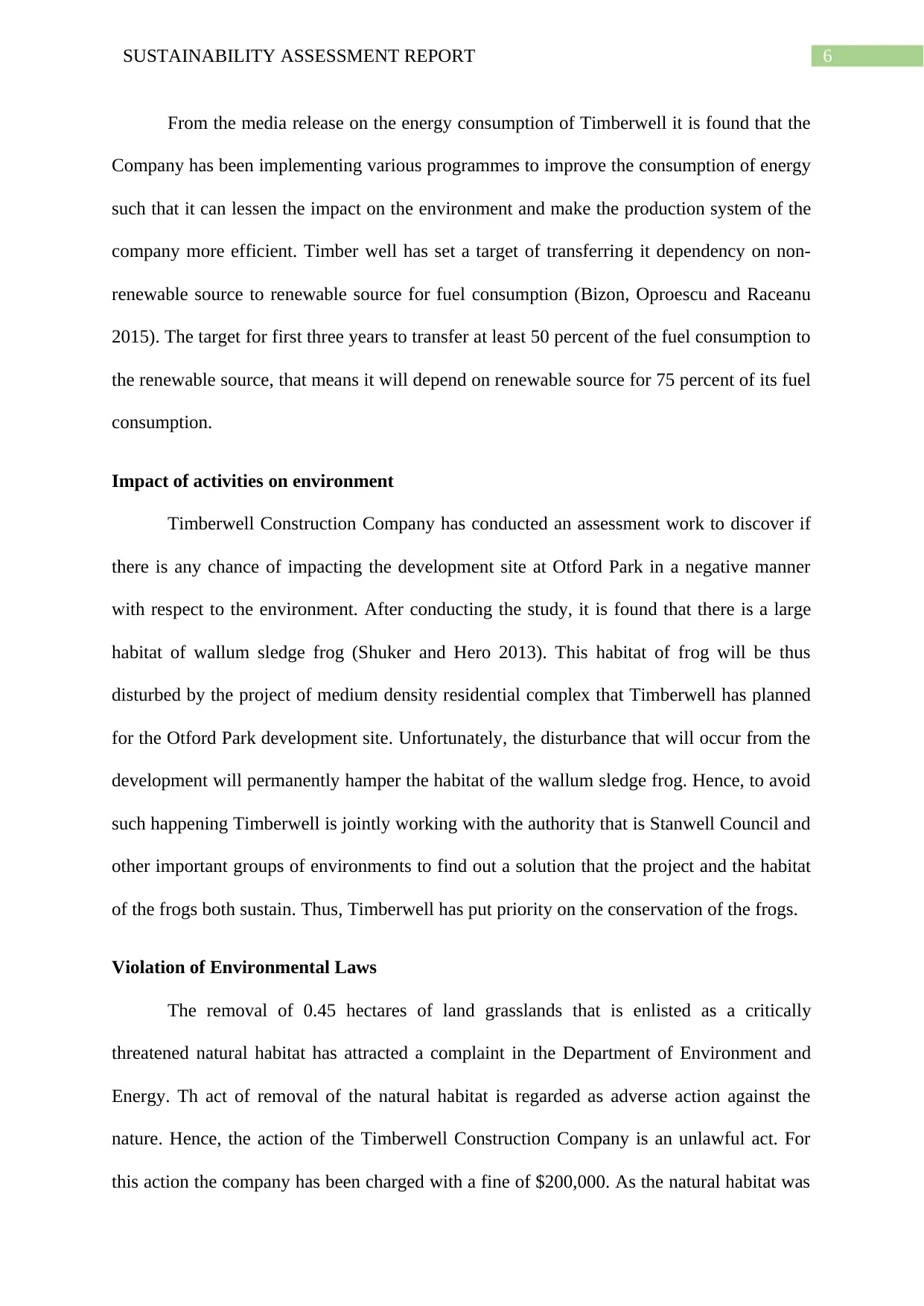
6SUSTAINABILITY ASSESSMENT REPORT
From the media release on the energy consumption of Timberwell it is found that the
Company has been implementing various programmes to improve the consumption of energy
such that it can lessen the impact on the environment and make the production system of the
company more efficient. Timber well has set a target of transferring it dependency on non-
renewable source to renewable source for fuel consumption (Bizon, Oproescu and Raceanu
2015). The target for first three years to transfer at least 50 percent of the fuel consumption to
the renewable source, that means it will depend on renewable source for 75 percent of its fuel
consumption.
Impact of activities on environment
Timberwell Construction Company has conducted an assessment work to discover if
there is any chance of impacting the development site at Otford Park in a negative manner
with respect to the environment. After conducting the study, it is found that there is a large
habitat of wallum sledge frog (Shuker and Hero 2013). This habitat of frog will be thus
disturbed by the project of medium density residential complex that Timberwell has planned
for the Otford Park development site. Unfortunately, the disturbance that will occur from the
development will permanently hamper the habitat of the wallum sledge frog. Hence, to avoid
such happening Timberwell is jointly working with the authority that is Stanwell Council and
other important groups of environments to find out a solution that the project and the habitat
of the frogs both sustain. Thus, Timberwell has put priority on the conservation of the frogs.
Violation of Environmental Laws
The removal of 0.45 hectares of land grasslands that is enlisted as a critically
threatened natural habitat has attracted a complaint in the Department of Environment and
Energy. Th act of removal of the natural habitat is regarded as adverse action against the
nature. Hence, the action of the Timberwell Construction Company is an unlawful act. For
this action the company has been charged with a fine of $200,000. As the natural habitat was
From the media release on the energy consumption of Timberwell it is found that the
Company has been implementing various programmes to improve the consumption of energy
such that it can lessen the impact on the environment and make the production system of the
company more efficient. Timber well has set a target of transferring it dependency on non-
renewable source to renewable source for fuel consumption (Bizon, Oproescu and Raceanu
2015). The target for first three years to transfer at least 50 percent of the fuel consumption to
the renewable source, that means it will depend on renewable source for 75 percent of its fuel
consumption.
Impact of activities on environment
Timberwell Construction Company has conducted an assessment work to discover if
there is any chance of impacting the development site at Otford Park in a negative manner
with respect to the environment. After conducting the study, it is found that there is a large
habitat of wallum sledge frog (Shuker and Hero 2013). This habitat of frog will be thus
disturbed by the project of medium density residential complex that Timberwell has planned
for the Otford Park development site. Unfortunately, the disturbance that will occur from the
development will permanently hamper the habitat of the wallum sledge frog. Hence, to avoid
such happening Timberwell is jointly working with the authority that is Stanwell Council and
other important groups of environments to find out a solution that the project and the habitat
of the frogs both sustain. Thus, Timberwell has put priority on the conservation of the frogs.
Violation of Environmental Laws
The removal of 0.45 hectares of land grasslands that is enlisted as a critically
threatened natural habitat has attracted a complaint in the Department of Environment and
Energy. Th act of removal of the natural habitat is regarded as adverse action against the
nature. Hence, the action of the Timberwell Construction Company is an unlawful act. For
this action the company has been charged with a fine of $200,000. As the natural habitat was
Paraphrase This Document
Need a fresh take? Get an instant paraphrase of this document with our AI Paraphraser
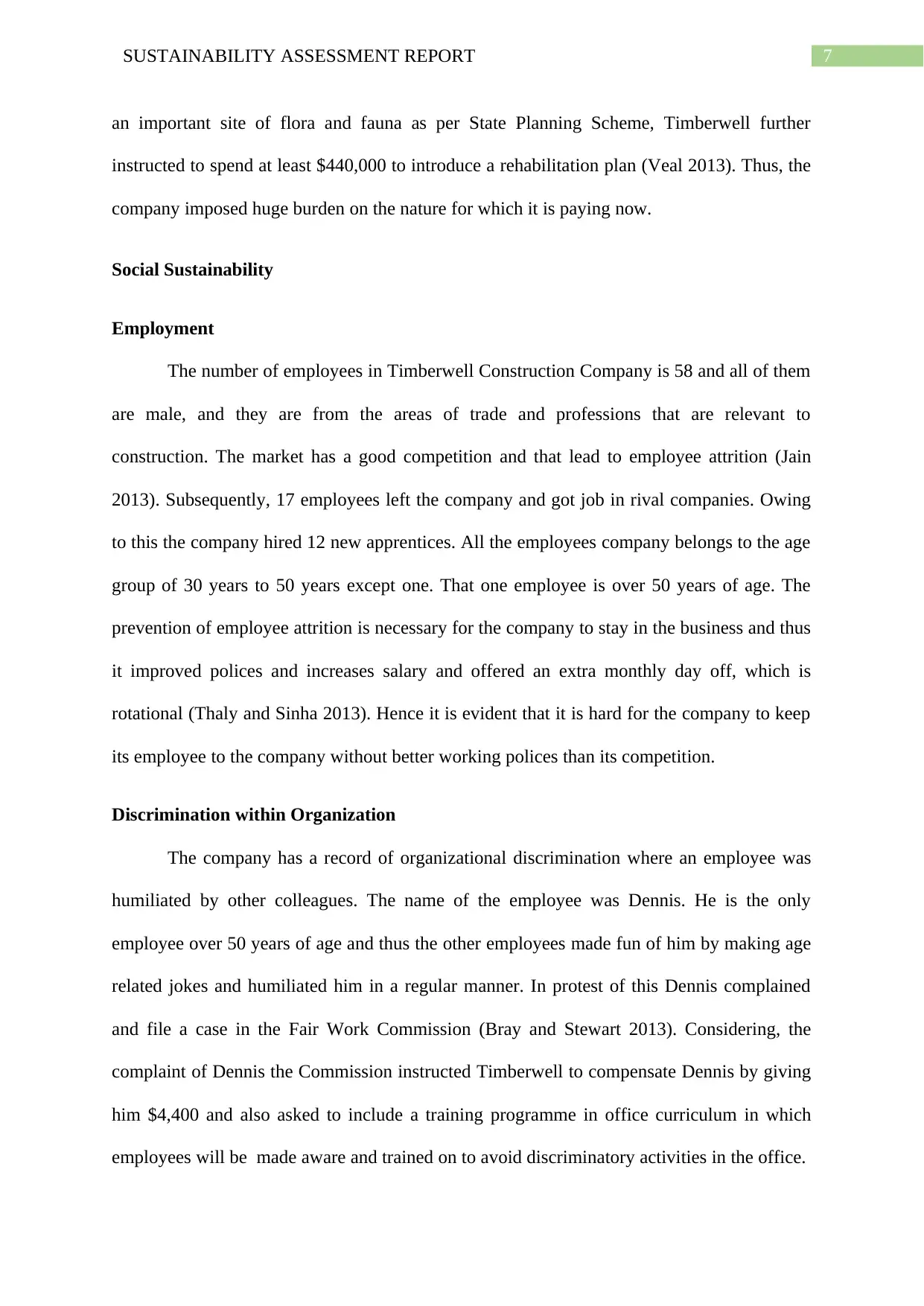
7SUSTAINABILITY ASSESSMENT REPORT
an important site of flora and fauna as per State Planning Scheme, Timberwell further
instructed to spend at least $440,000 to introduce a rehabilitation plan (Veal 2013). Thus, the
company imposed huge burden on the nature for which it is paying now.
Social Sustainability
Employment
The number of employees in Timberwell Construction Company is 58 and all of them
are male, and they are from the areas of trade and professions that are relevant to
construction. The market has a good competition and that lead to employee attrition (Jain
2013). Subsequently, 17 employees left the company and got job in rival companies. Owing
to this the company hired 12 new apprentices. All the employees company belongs to the age
group of 30 years to 50 years except one. That one employee is over 50 years of age. The
prevention of employee attrition is necessary for the company to stay in the business and thus
it improved polices and increases salary and offered an extra monthly day off, which is
rotational (Thaly and Sinha 2013). Hence it is evident that it is hard for the company to keep
its employee to the company without better working polices than its competition.
Discrimination within Organization
The company has a record of organizational discrimination where an employee was
humiliated by other colleagues. The name of the employee was Dennis. He is the only
employee over 50 years of age and thus the other employees made fun of him by making age
related jokes and humiliated him in a regular manner. In protest of this Dennis complained
and file a case in the Fair Work Commission (Bray and Stewart 2013). Considering, the
complaint of Dennis the Commission instructed Timberwell to compensate Dennis by giving
him $4,400 and also asked to include a training programme in office curriculum in which
employees will be made aware and trained on to avoid discriminatory activities in the office.
an important site of flora and fauna as per State Planning Scheme, Timberwell further
instructed to spend at least $440,000 to introduce a rehabilitation plan (Veal 2013). Thus, the
company imposed huge burden on the nature for which it is paying now.
Social Sustainability
Employment
The number of employees in Timberwell Construction Company is 58 and all of them
are male, and they are from the areas of trade and professions that are relevant to
construction. The market has a good competition and that lead to employee attrition (Jain
2013). Subsequently, 17 employees left the company and got job in rival companies. Owing
to this the company hired 12 new apprentices. All the employees company belongs to the age
group of 30 years to 50 years except one. That one employee is over 50 years of age. The
prevention of employee attrition is necessary for the company to stay in the business and thus
it improved polices and increases salary and offered an extra monthly day off, which is
rotational (Thaly and Sinha 2013). Hence it is evident that it is hard for the company to keep
its employee to the company without better working polices than its competition.
Discrimination within Organization
The company has a record of organizational discrimination where an employee was
humiliated by other colleagues. The name of the employee was Dennis. He is the only
employee over 50 years of age and thus the other employees made fun of him by making age
related jokes and humiliated him in a regular manner. In protest of this Dennis complained
and file a case in the Fair Work Commission (Bray and Stewart 2013). Considering, the
complaint of Dennis the Commission instructed Timberwell to compensate Dennis by giving
him $4,400 and also asked to include a training programme in office curriculum in which
employees will be made aware and trained on to avoid discriminatory activities in the office.
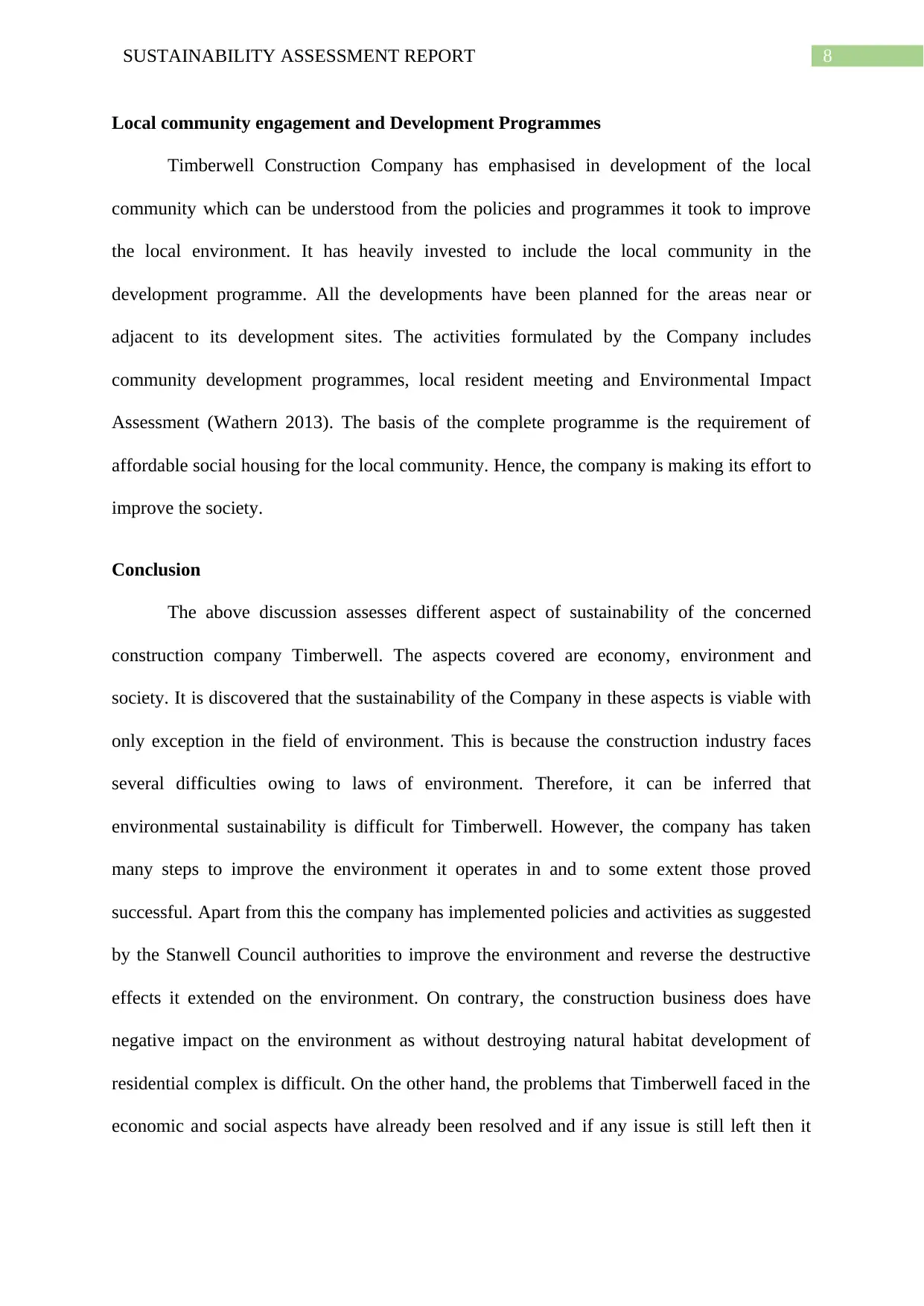
8SUSTAINABILITY ASSESSMENT REPORT
Local community engagement and Development Programmes
Timberwell Construction Company has emphasised in development of the local
community which can be understood from the policies and programmes it took to improve
the local environment. It has heavily invested to include the local community in the
development programme. All the developments have been planned for the areas near or
adjacent to its development sites. The activities formulated by the Company includes
community development programmes, local resident meeting and Environmental Impact
Assessment (Wathern 2013). The basis of the complete programme is the requirement of
affordable social housing for the local community. Hence, the company is making its effort to
improve the society.
Conclusion
The above discussion assesses different aspect of sustainability of the concerned
construction company Timberwell. The aspects covered are economy, environment and
society. It is discovered that the sustainability of the Company in these aspects is viable with
only exception in the field of environment. This is because the construction industry faces
several difficulties owing to laws of environment. Therefore, it can be inferred that
environmental sustainability is difficult for Timberwell. However, the company has taken
many steps to improve the environment it operates in and to some extent those proved
successful. Apart from this the company has implemented policies and activities as suggested
by the Stanwell Council authorities to improve the environment and reverse the destructive
effects it extended on the environment. On contrary, the construction business does have
negative impact on the environment as without destroying natural habitat development of
residential complex is difficult. On the other hand, the problems that Timberwell faced in the
economic and social aspects have already been resolved and if any issue is still left then it
Local community engagement and Development Programmes
Timberwell Construction Company has emphasised in development of the local
community which can be understood from the policies and programmes it took to improve
the local environment. It has heavily invested to include the local community in the
development programme. All the developments have been planned for the areas near or
adjacent to its development sites. The activities formulated by the Company includes
community development programmes, local resident meeting and Environmental Impact
Assessment (Wathern 2013). The basis of the complete programme is the requirement of
affordable social housing for the local community. Hence, the company is making its effort to
improve the society.
Conclusion
The above discussion assesses different aspect of sustainability of the concerned
construction company Timberwell. The aspects covered are economy, environment and
society. It is discovered that the sustainability of the Company in these aspects is viable with
only exception in the field of environment. This is because the construction industry faces
several difficulties owing to laws of environment. Therefore, it can be inferred that
environmental sustainability is difficult for Timberwell. However, the company has taken
many steps to improve the environment it operates in and to some extent those proved
successful. Apart from this the company has implemented policies and activities as suggested
by the Stanwell Council authorities to improve the environment and reverse the destructive
effects it extended on the environment. On contrary, the construction business does have
negative impact on the environment as without destroying natural habitat development of
residential complex is difficult. On the other hand, the problems that Timberwell faced in the
economic and social aspects have already been resolved and if any issue is still left then it
⊘ This is a preview!⊘
Do you want full access?
Subscribe today to unlock all pages.

Trusted by 1+ million students worldwide
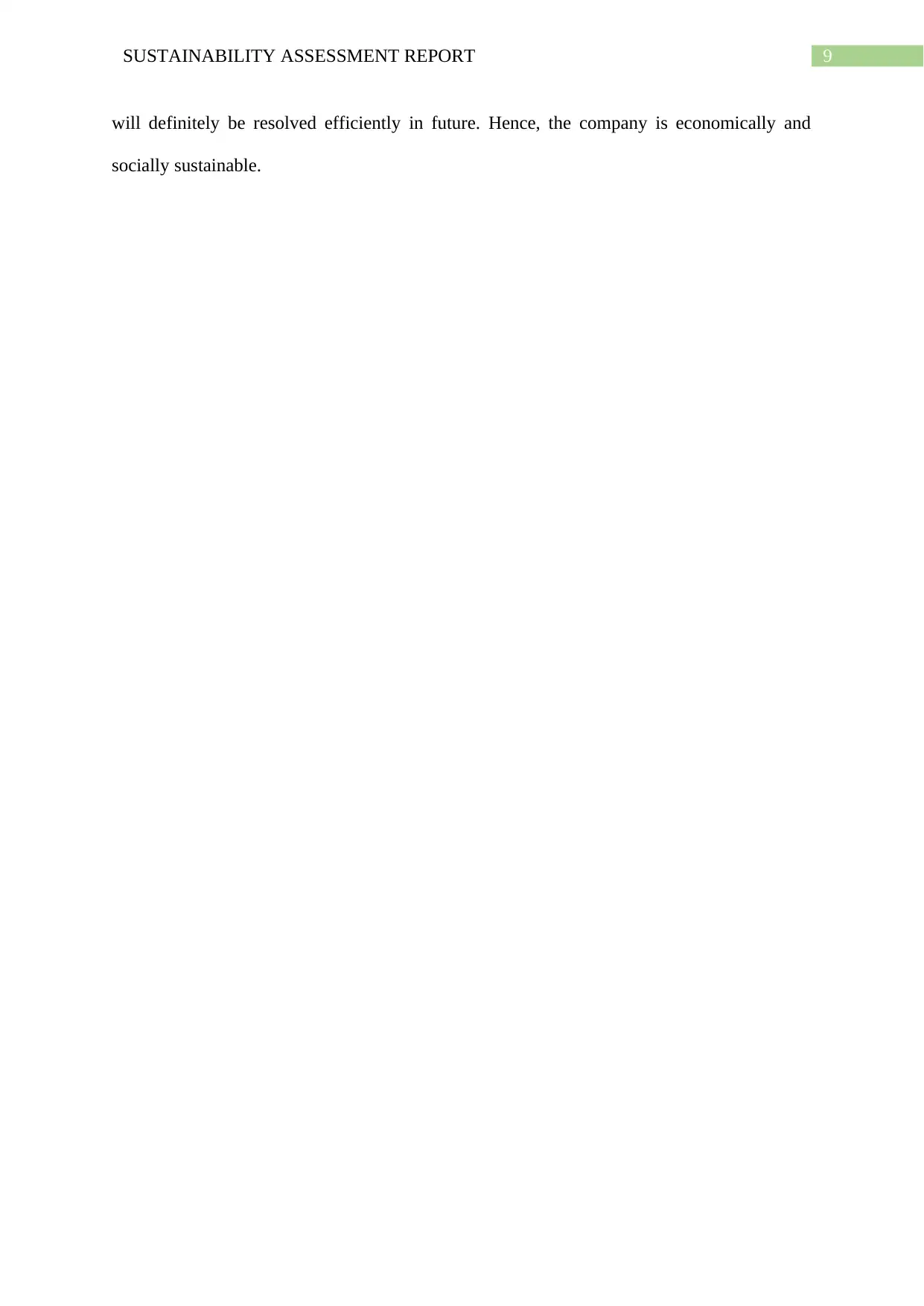
9SUSTAINABILITY ASSESSMENT REPORT
will definitely be resolved efficiently in future. Hence, the company is economically and
socially sustainable.
will definitely be resolved efficiently in future. Hence, the company is economically and
socially sustainable.
Paraphrase This Document
Need a fresh take? Get an instant paraphrase of this document with our AI Paraphraser
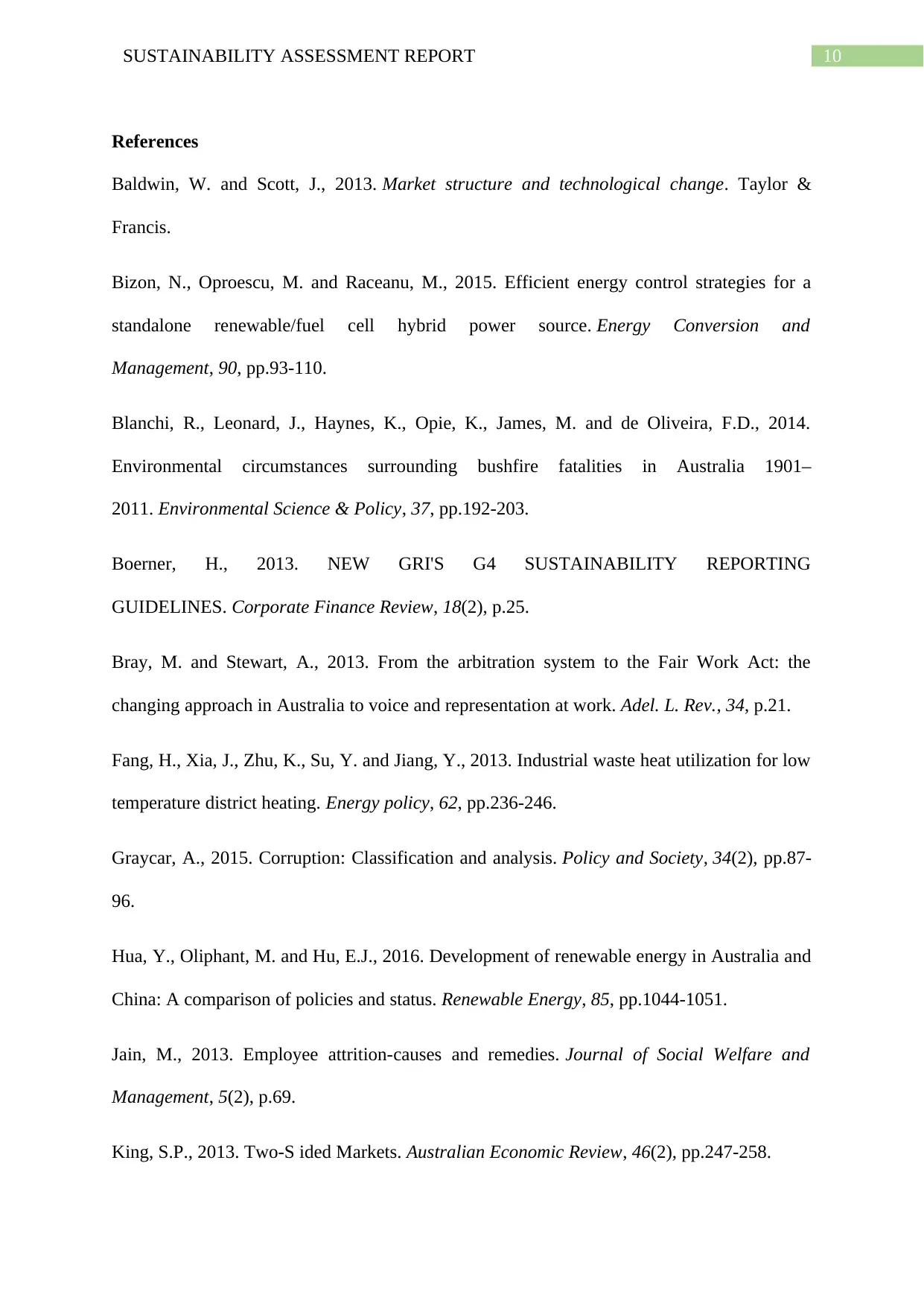
10SUSTAINABILITY ASSESSMENT REPORT
References
Baldwin, W. and Scott, J., 2013. Market structure and technological change. Taylor &
Francis.
Bizon, N., Oproescu, M. and Raceanu, M., 2015. Efficient energy control strategies for a
standalone renewable/fuel cell hybrid power source. Energy Conversion and
Management, 90, pp.93-110.
Blanchi, R., Leonard, J., Haynes, K., Opie, K., James, M. and de Oliveira, F.D., 2014.
Environmental circumstances surrounding bushfire fatalities in Australia 1901–
2011. Environmental Science & Policy, 37, pp.192-203.
Boerner, H., 2013. NEW GRI'S G4 SUSTAINABILITY REPORTING
GUIDELINES. Corporate Finance Review, 18(2), p.25.
Bray, M. and Stewart, A., 2013. From the arbitration system to the Fair Work Act: the
changing approach in Australia to voice and representation at work. Adel. L. Rev., 34, p.21.
Fang, H., Xia, J., Zhu, K., Su, Y. and Jiang, Y., 2013. Industrial waste heat utilization for low
temperature district heating. Energy policy, 62, pp.236-246.
Graycar, A., 2015. Corruption: Classification and analysis. Policy and Society, 34(2), pp.87-
96.
Hua, Y., Oliphant, M. and Hu, E.J., 2016. Development of renewable energy in Australia and
China: A comparison of policies and status. Renewable Energy, 85, pp.1044-1051.
Jain, M., 2013. Employee attrition-causes and remedies. Journal of Social Welfare and
Management, 5(2), p.69.
King, S.P., 2013. Two‐S ided Markets. Australian Economic Review, 46(2), pp.247-258.
References
Baldwin, W. and Scott, J., 2013. Market structure and technological change. Taylor &
Francis.
Bizon, N., Oproescu, M. and Raceanu, M., 2015. Efficient energy control strategies for a
standalone renewable/fuel cell hybrid power source. Energy Conversion and
Management, 90, pp.93-110.
Blanchi, R., Leonard, J., Haynes, K., Opie, K., James, M. and de Oliveira, F.D., 2014.
Environmental circumstances surrounding bushfire fatalities in Australia 1901–
2011. Environmental Science & Policy, 37, pp.192-203.
Boerner, H., 2013. NEW GRI'S G4 SUSTAINABILITY REPORTING
GUIDELINES. Corporate Finance Review, 18(2), p.25.
Bray, M. and Stewart, A., 2013. From the arbitration system to the Fair Work Act: the
changing approach in Australia to voice and representation at work. Adel. L. Rev., 34, p.21.
Fang, H., Xia, J., Zhu, K., Su, Y. and Jiang, Y., 2013. Industrial waste heat utilization for low
temperature district heating. Energy policy, 62, pp.236-246.
Graycar, A., 2015. Corruption: Classification and analysis. Policy and Society, 34(2), pp.87-
96.
Hua, Y., Oliphant, M. and Hu, E.J., 2016. Development of renewable energy in Australia and
China: A comparison of policies and status. Renewable Energy, 85, pp.1044-1051.
Jain, M., 2013. Employee attrition-causes and remedies. Journal of Social Welfare and
Management, 5(2), p.69.
King, S.P., 2013. Two‐S ided Markets. Australian Economic Review, 46(2), pp.247-258.
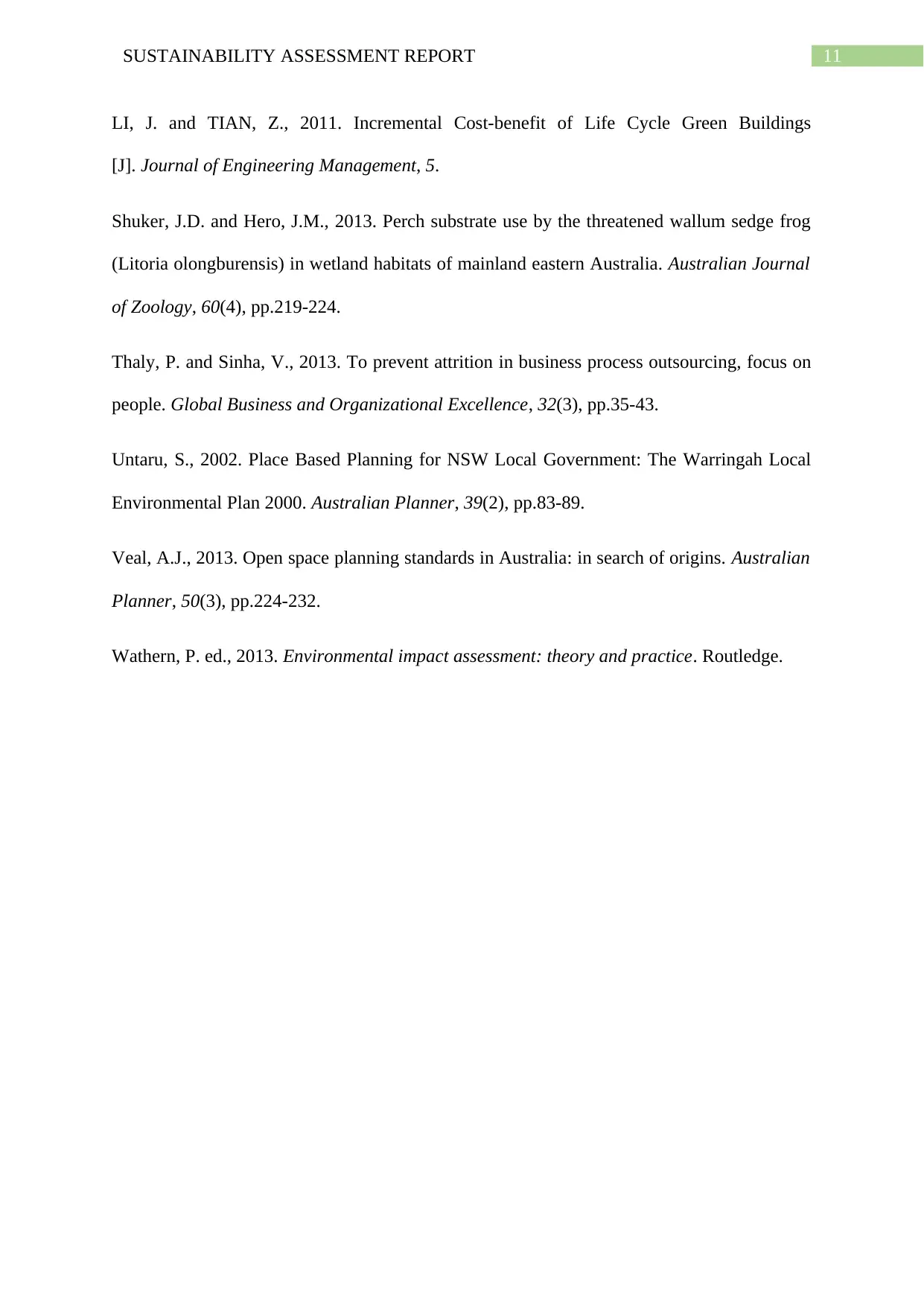
11SUSTAINABILITY ASSESSMENT REPORT
LI, J. and TIAN, Z., 2011. Incremental Cost-benefit of Life Cycle Green Buildings
[J]. Journal of Engineering Management, 5.
Shuker, J.D. and Hero, J.M., 2013. Perch substrate use by the threatened wallum sedge frog
(Litoria olongburensis) in wetland habitats of mainland eastern Australia. Australian Journal
of Zoology, 60(4), pp.219-224.
Thaly, P. and Sinha, V., 2013. To prevent attrition in business process outsourcing, focus on
people. Global Business and Organizational Excellence, 32(3), pp.35-43.
Untaru, S., 2002. Place Based Planning for NSW Local Government: The Warringah Local
Environmental Plan 2000. Australian Planner, 39(2), pp.83-89.
Veal, A.J., 2013. Open space planning standards in Australia: in search of origins. Australian
Planner, 50(3), pp.224-232.
Wathern, P. ed., 2013. Environmental impact assessment: theory and practice. Routledge.
LI, J. and TIAN, Z., 2011. Incremental Cost-benefit of Life Cycle Green Buildings
[J]. Journal of Engineering Management, 5.
Shuker, J.D. and Hero, J.M., 2013. Perch substrate use by the threatened wallum sedge frog
(Litoria olongburensis) in wetland habitats of mainland eastern Australia. Australian Journal
of Zoology, 60(4), pp.219-224.
Thaly, P. and Sinha, V., 2013. To prevent attrition in business process outsourcing, focus on
people. Global Business and Organizational Excellence, 32(3), pp.35-43.
Untaru, S., 2002. Place Based Planning for NSW Local Government: The Warringah Local
Environmental Plan 2000. Australian Planner, 39(2), pp.83-89.
Veal, A.J., 2013. Open space planning standards in Australia: in search of origins. Australian
Planner, 50(3), pp.224-232.
Wathern, P. ed., 2013. Environmental impact assessment: theory and practice. Routledge.
⊘ This is a preview!⊘
Do you want full access?
Subscribe today to unlock all pages.

Trusted by 1+ million students worldwide
1 out of 12
Related Documents
Your All-in-One AI-Powered Toolkit for Academic Success.
+13062052269
info@desklib.com
Available 24*7 on WhatsApp / Email
![[object Object]](/_next/static/media/star-bottom.7253800d.svg)
Unlock your academic potential
Copyright © 2020–2025 A2Z Services. All Rights Reserved. Developed and managed by ZUCOL.





